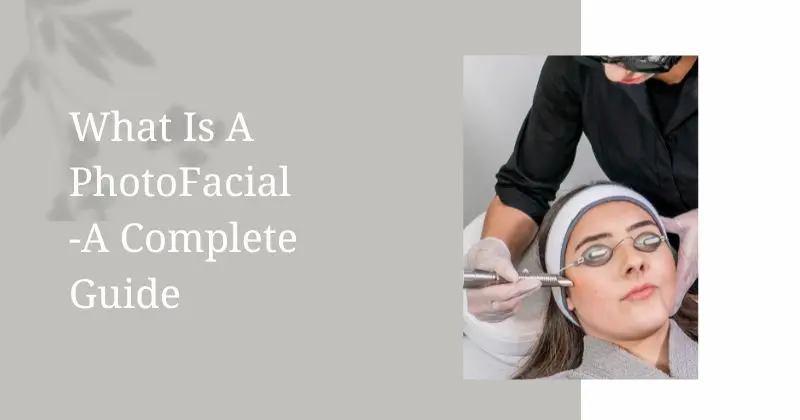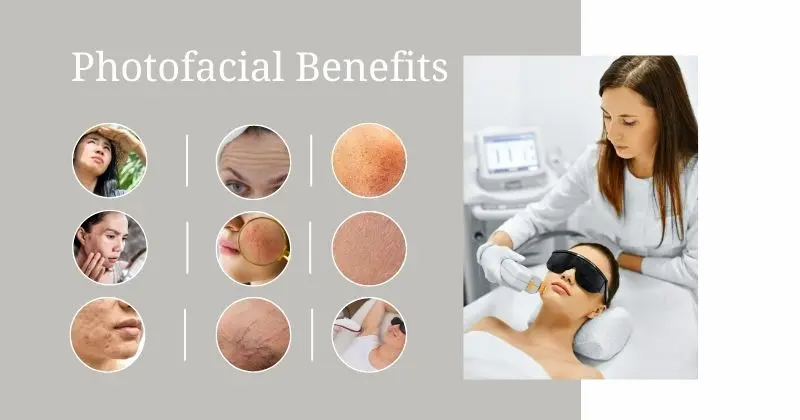What Is a PhotoFacial – Benefits, Side Effects, Post Care Treatment, Cost Everything You Must Know

Photofacial is also known as photorejuvenation, IPL rejuvenation, and BBL (Broad Band Light). It is a non-invasive cosmetic procedure to treat various skin problems. It is similar to a laser, but technically, it is not. Explore more about what a photo facial is, its benefits, and other important things you must know.
What Is Photofacial:
Photofacial therapy or intense pulsed light (IPL) is a non-invasive cosmetic procedure that emits different colors of light in a broad wavelength range of 515-1200 nm. Photo laser facial is used to treat various skin issues across different skin types. However, it was originally used to treat problems like redness that happens due to the blood vessels in the skin.
After some, due to the help of different filters, it was found effective in treating other skin issues like reducing wrinkles, hyperpigmentation, rosacea, sun damage, and unwanted dark spots.
Photofacial or IPL is a non-ablative type because it does not actually use lasers. IPL is different from laser due to its recovery time, and it does not injure your top layer of skin to reveal newer.
Types Of Photofacial:
Usually, there are two types of methods used for photo facials.
- Intense Pulse Light (IPL).
- Light Emitting Diode (LED).
How Does It Work:
In both types of photo facials, noncoherent (different wavelength) light is emitted and penetrates into the skin. When this light penetrates, it produces heat and stimulates collagen production in the deeper layer of the skin without harming its nearest cell, resulting in an improvement in skin elasticity and texture with the passage of time. As the light emission is in different wavelengths, they are able to target different skin issues simultaneously.
You May Also Like 13 Amazing Benefits of Carbon Laser Facial Treatment | Carbon Laser Peel Side Effect.
Benefits of PhotoFacial:

Photofacial benefits are not limited to improving skin texture. It offers a wide range of treatments with visible results. Here are some common issues that IPL treats:
- Sun Damage.
- Hyperpigmentation.
- Acne, Acne Scars, and Blemishes.
- Fine lines and wrinkles.
- Spider vein and Broken Capillaries.
- Textured Skin.
- Rosacea.
- Lover spots, Freckles, Age Spots.
- Unwanted Hairs.
- Redness and Flushing.
Photofacial Side Effects:
Due to the mild wavelength of light, the side effects of photo facial or IPL are very rare, but they still exist. These side effects are generally due to untrained technicians. Some of the potential side effects are:
- Pain
- Burns
- Excessive redness
- Blistering
- Swelling
- Overstimulated hair growth
- Hyper- or hypopigmentation
- Whitened hair in the area
- Crusting
- Scarring
- Keloid scarring
- Eye damage
- Blood clots
- Infection
What to Expect During a Photofacial Treatment Session:
It is good to consult with a dermatologist about all your skin concerns before your photo facial treatment. This will help the expert to determine the most suitable treatment plan for you.
On the day of your session, here’s what to expect:
- Cleansing and numbing: Experts will clean your treatment area to remove any dirt, oil, or residue, and then a numbing cream may be applied to reduce the discomfort during the procedure.
- Application of a cooling gel: A cooling gel will be applied to enhance the effectiveness of the light pulse and protect the treated area.
- Light pulses: Then, the light will be passed through the device over the skin. Experts will control the delivery of light, mild sensation you may feel, but it is generally well tolerated.
- Post-treatment care: After treatment, a soothing gel or moisturizer will be applied to minimize the redness or inflammation. After treatment, post-treatment care and maintenance must be followed. Professional’s instructions regarding post-treatment care and maintenance.
Post-treatment Care And Tips:
If you want to achieve desired results and maintain your photofacial treatment you must follow post-treatment care and maintenance guidelines given by your skin care professional. Here are some common tips that you must remember:
- Avoid sun exposure.
- Moisturize regularly.
- Don’t scratch your treated area.
- Do Not use any makeup for at least 48 hours.
- Avoid harsh chemical products on your treated area, and skip your skincare routine till your skincare professional recommends you.
- Drink a lot of water to keep yourself hydrated.
- Do Not use retinol, retinoid, or glycolic acid products. Use ceramide and hyaluronic acid-based products as they speed up the healing process.
Who Should Not Have IPL:
- People who have dark skin tones are at the risk of burning or hyperpigmentation after treatment.
- Pregnant women should avoid this treatment because it may affect the fetus.
- Individuals with certain medical conditions such as diabetes, skin cancer, or active skin infections.
- People with recent sunburn or tanning.
Recovery time:
Recovery time after IPL (Intense Pulsed Light) treatment is generally minimal compared to more invasive procedures. However, the exact recovery period can vary depending on factors such as the intensity of the treatment, the area treated, and individual skin sensitivity.
Related Post:
How Much Is a Photofacial Cost?
The cost of an IPL (Intense Pulsed Light) photo facial can vary depending on several factors, including the location of the treatment facility, the experience of the provider, the specific area being treated, and the number of sessions required. On average, however, the cost of a single IPL photo facial session typically ranges from $300 to $600 USD.
Conclusion:
Intense pulsed technology is a versatile, efficient, and safe treatment for vascular and pigmented lesions, photoaging, acne, rosacea, actinic keratoses, and nonmelanoma skin cancers. The efficacy of IPL treatment depends on the distribution of wavelength, filters, pulse duration, and frequencies.
Resources:
- https://www.pmuhub.com/ipl-photofacial/
- https://www.ncbi.nlm.nih.gov/pmc/articles/PMC6983864/
- https://books.google.com.pk/books?hl=en&lr=&id=WxLfU4QX2dEC&oi=fnd&pg=PA47&dq=what+is+a+photofacial&ots=-jWqwQUULp&sig=cLVkb903BRr-gs6K-w4S_XVbjvI&redir_esc=y#v=onepage&q&f=false
- https://www.webmd.com/beauty/intense-pulsed-light-treatment-overview
- https://www.ncbi.nlm.nih.gov/pmc/articles/PMC3390232/

